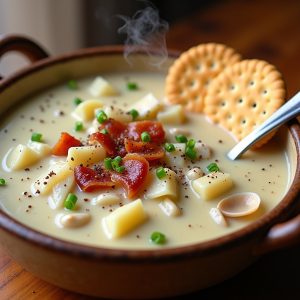
AI generated image
Chef's Tip
For the best texture, avoid overcooking the potatoes and add the clams at the very end of cooking. This prevents the clams from becoming tough and keeps the potatoes from disintegrating into the broth.
Instructions
- In a large pot, bring 2 cups of water to a boil. Add clams, cover, and steam until they open, about 5-10 minutes. Remove clams as they open. Discard any that don't open after 15 minutes.
- Strain clam broth through a fine-mesh sieve lined with cheesecloth to remove any grit. Reserve 3 cups of broth.
- Remove clams from shells. Chop the clam meat into bite-sized pieces and set aside.
- In a large heavy pot or Dutch oven, cook bacon over medium heat until crisp, about 5 minutes. Remove bacon with a slotted spoon and set aside, leaving the fat in the pot.
- Add butter to the bacon fat. When melted, add onion and celery. Cook until vegetables are soft but not browned, about 5-7 minutes. Add garlic and cook for 30 seconds more.
- Sprinkle flour over the vegetables and stir constantly for 1-2 minutes to make a roux.
- Slowly whisk in the white wine, scraping up any browned bits from the bottom of the pot. Cook for 1 minute to burn off alcohol.
- Gradually add reserved clam broth and bottled clam juice, whisking continuously to prevent lumps.
- Add bay leaf, thyme sprigs, and potatoes. Bring to a simmer, then reduce heat to maintain a gentle simmer. Cook until potatoes are tender but not falling apart, about 15 minutes.
- Stir in heavy cream and milk. Return to a gentle simmer (do not boil) and cook for 5 minutes.
- Remove bay leaf and thyme sprigs. Add chopped clams and reserved bacon. Simmer gently just until clams are heated through, about 2 minutes.
- Season with salt and white pepper to taste. If the chowder is too thick, thin with a little more milk.
Plating
Ladle the hot chowder into warmed bowls. Sprinkle with chopped fresh chives and a few grinds of black pepper. Serve with oyster crackers on the side for guests to add as desired.
Storage & Reheating
Store cooled chowder in an airtight container in the refrigerator for up to 3 days. Reheat gently over low heat, stirring occasionally and adding a splash of milk if needed to maintain consistency. Do not bring to a boil when reheating as this may cause the cream to separate and the clams to toughen. Not recommended for freezing.
About This Recipe
New England clam chowder represents one of the region's most beloved culinary traditions. This version builds on Jacob Wirth's award-winning recipe, maintaining the balance of creamy broth, tender clams, and smoky bacon that made it famous. By using fresh clams and their natural broth, this adaptation preserves the authentic oceanic flavor while creating a satisfying texture that showcases New England's seafood heritage.
